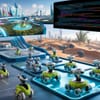Researchers at MIT Computer Science and Artificial Intelligence Laboratory (CSAIL), in collaboration with the Toyota Research Institute, have developed a new method called “Steerable Scene Generation” that leverages generative-AI techniques to construct realistic 3D simulated environments—such as kitchens, living rooms and restaurants—where virtual robots can perform interactions and tasks. The motivation is that real-world robot training data is expensive and slow to collect, and many existing simulators rely on hand-crafted environments or simplistic distributions that don’t reflect real-world complexity.
The new approach works by training a diffusion model on a vast dataset of over 44 million 3D room scenes filled with objects like tables, plates, utensils and furniture. Then it uses a Monte Carlo Tree Search (MCTS) strategy at inference time to “steer” the scene generation toward specific objectives—for instance, creating more physically realistic object placements or higher-density scenes than seen in the training data. One experiment produced a restaurant scene with 34 objects on a table, significantly above the average of 17 in the original dataset.
The practical upshot is that robotics researchers can now generate highly varied, realistic virtual training settings—prompting the system with instructions like “a kitchen with four apples and a bowl on the table”—and obtaining a scene with ~98% fidelity in simple setups and ~86% for more chaotic ones, outperforming competing methods by over 10%. This flexibility means virtual training data can be diversified to better reflect the messy, unpredictable nature of real-world environments, which helps reduce the “simulation-to-reality” gap in robotics.
Looking ahead, the research underscores that while this is still proof-of-concept, the next steps include generating entirely new objects (not just rearranging existing libraries), supporting articulated and interactive items (drawers, jars, food packages) and further aligning simulation with deployment in homes, factories and service environments. The work suggests a future where robots can be trained more rapidly, at lower cost, and in richer virtual worlds—potentially accelerating the rollout of capable robotic assistants.


